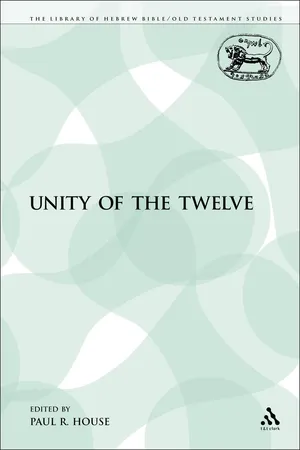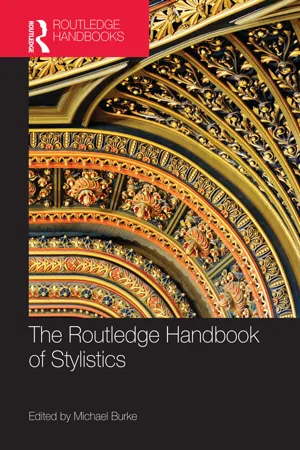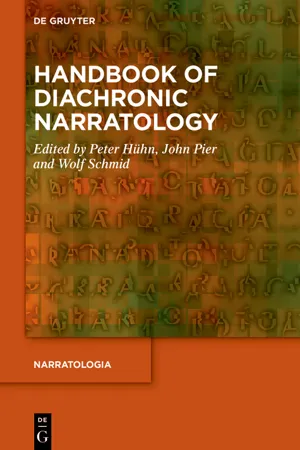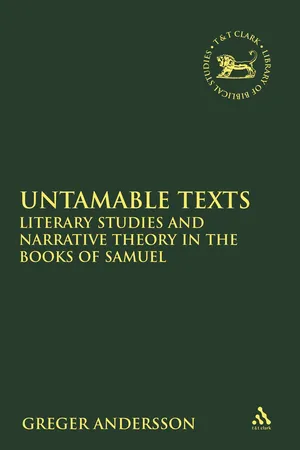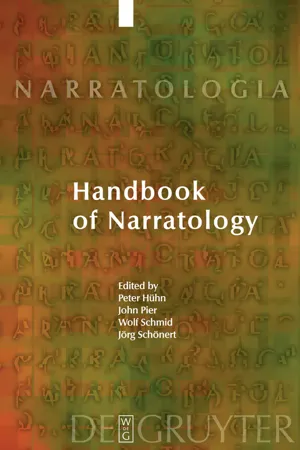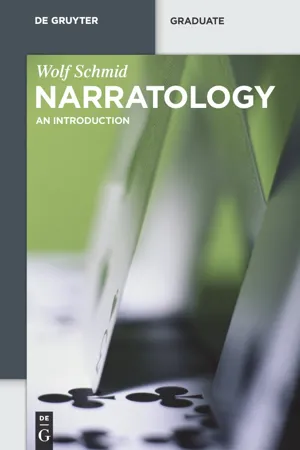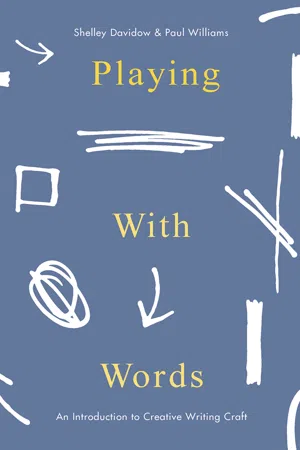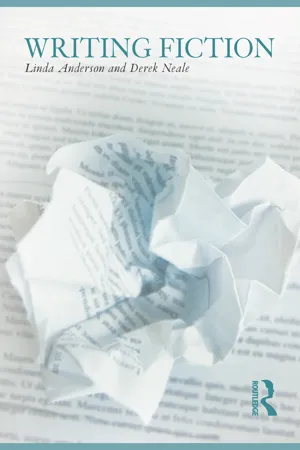Literature
Point of View
"Point of view" in literature refers to the perspective from which a story is told. It encompasses the narrator's position in relation to the events and characters, and can be first person (using "I" or "we"), second person (using "you"), or third person (using "he," "she," or "they"). The choice of point of view influences the reader's understanding and emotional connection to the narrative.
Written by Perlego with AI-assistance
Related key terms
1 of 5
11 Key excerpts on "Point of View"
- eBook - PDF
- Paul R. House(Author)
- 1990(Publication Date)
- Sheffield Academic Press(Publisher)
Chapter 6 THE TWELVE'S Point of View Introduction: Major Aspects of Point of View Few areas of literary criticism are as complex as Point of View. Numerous methodologies have been forwarded for examin-ing the subject, many of which vary a great deal. Point of View is the process of discovering who tells a story, how it is told, how accurately it is told, and with what amount of knowledge and understanding it unfolds. All these aspects help reveal the vantage point from which an event is seen and narrated. As can be ascertained from the preceding definition, two subjects comprise the major concerns of Point of View: who tells the story and how it is told. The first concern is usually handled under discussions about narrators and their audiences, and the second under the many types of narration. In the past twenty to thirty years so many studies of Point of View have appeared that the interpreter must select and use only those facets of the discipline that best illuminate the lit-erature under scrutiny. Wallace Martin's excellent survey Recent Theories of Narrative demonstrates the current explosion of interest in the whole area of narration. In his chapter on Point of View Martin notes four aspects that have normally characterized studies of the subject since Anne Bar-bauld's 1804 analysis of Samuel Richardson's fiction. Martin believes that though writers have discovered new methods of narration since Barbauld's time, her conceptual distinctions survive in recent criticism. First there is that of grammatical person or voice: who writes? Apart from experimental fiction, the nar-rator tells either a story about others... or one in which he or she is involved... Second, there are different kinds of dis-course: narration, dramatic presentation (quoted dialogue or 222 The Unity of the Twelve monologue), and a catchall category often called 'comment-ary' (exposition, interpretation, judgment and possibly digressions interpolated by the narrator). - No longer available |Learn more
- Michael Burke(Author)
- 2017(Publication Date)
- Routledge(Publisher)
1993 ) and others demonstrate, the concept of modality can be utilised to systematically identify the linguistic means by which various differing points of view are manifested in narratives. As such, the interactions between Point of View and modality will be discussed in detail, and will include an outline of the four modal systems found in English and the provision of illustrative examples which enable the formalisation of a grammar of Point of View through placement within a modal frame. Finally, a consideration of future research into narrative Point of View will illustrate the growing trend towards expanding its application.Point of View
Point of View in literature refers to the ‘angle of telling’ of a narrative act – that is, the perspective from which events and/or thoughts are related. A pivotal concern in literary criticism since the rise of the novel throughout the eighteenth century, the increasing internalisation of narrative viewpoint characteristic of literary production since the early twentieth century has stimulated much research into this complex construct. Central to the concept of narrative viewpoint is the distinction between who tells and who sees. In the case of a first-person narrative, for example, events are both ‘told’ and ‘seen’ by the same entity, an ‘I-narrator’; in third-person narration, the ‘story-teller’ and the ‘viewer’ are separate entities. Point of View is an effect produced by the process of narration, with perspective being embedded in the very act of narration even in its most basic form. Consider, for example, that you and a friend are sitting in a sparsely furnished room, facing one another across a table. The only additional object in the room is a coat-stand in the corner. Both of you are asked to describe the room to each other. You might commence with a description of the colour of the walls or the carpet; you may mention the coat-stand to your right. Your friend, sitting across from you, will possibly describe the same things, including the coat-stand to his/her left. Immediately, then, there is a difference in the spatial perspective being offered: you are both describing the same coat-stand, but its spatial location differs according to your visual perspective. This is a very simple example of how Point of View effects are encoded in a narrative, and spatial Point of View is just one of a number of different types of viewpoint. For instance, your description of the room might be limited to a categorisation of its physical features; your friend, however, noting the sparsity of the surroundings, might describe the room as depressing or gloomy. You are both reporting on the very same room, but your friend has now augmented the narration of their spatial Point of View with a description of their psychological Point of View - eBook - ePub
- Peter Hühn, John Pier, Wolf Schmid, Peter Hühn, John Pier, Wolf Schmid(Authors)
- 2023(Publication Date)
- De Gruyter(Publisher)
Point of View in Russian Literature
Andrej Agratin1 Definition
Point of View (PoV) is the position taken by a narrator toward the storyworld.It was the writer Henry James who first spoke extensively about narrative Point of View, although similar reasoning can be found in theoretical works by Otto Ludwig, Friedrich Spielhagen, and Lev Tolstoj (Tamarčenko 2008 , 266). The concept of Point of View entered Anglo-American scholarly use through the English literary critic Percy Lubbock ([1921] 1972).The concept of PoV is transdisciplinary in nature and applies to all representational art forms as well as to non-artistic communicative practices (see Uspenskij [1970] 1973).2 Exploring Point of View
The term “Point of View” is similar to the terms “perspective” (P) and “focalization” (F). Often, the three concepts are used synonymously. Nevertheless, some differences between them can be traced. P is usually understood as the subjective worldview of a character or narrator (if the latter is personified). In the framework of constructivist approaches to narrative, the term indicates the specifics of reader activity: the recipient inevitably transfers his ideas about the person and the human mind to the hero (builds his “perspective”), so that his existence is conceived as pseudo-real (Surkamp 2005 , 424). However, classical narratology does not imply a strict distinction between P and PoV. In the vast majority of contexts, they are interchangeable (Niederhoff 2014b ). This principle is also accepted in this article.The concept of focalization introduced by Gérard Genette ([1972] 1980, 185–198; [1983] 1988, 72–78) is a bit more complicated. The new term was intended to replace the overly metaphorical notion of PoV. Describing the structure of the narrative text, Genette proposes to distinguish two questions: “Who says?” and “Who sees?” He emphasizes that the subject of the story and the PoV are independent parameters of the narrative. In fact, Genette’s opinion looks quite novel compared to the findings of his predecessors. For example, Franz Stanzel formulated a theory of narrative situations ([1955] 1971). There are three such situations: the authorial narrative situation (dominance of the narrator’s viewpoint), the figural narrative situation (a story told from the hero’s viewpoint), and the first-person narrative situation (a story told by a personalized narrator). Apparently, in the third situation, as in the second, the narrator is able to convey the character’s P, but Stanzel ignores this possibility because he believes that the type of narrator and the “optics” of the narrative are related parameters. The same attitude is characteristic of the earlier typologies of Lubbock ([1921] 1972) and Norman Friedman ([1955] 1967). It should be added that the above remarks on Stanzel’s theory are consistent with Dorrit Cohn’s (1981) - eBook - PDF
Untamable Texts
Literary Studies and Narrative Theory in the Books of Samuel
- Greger Andersson(Author)
- 2009(Publication Date)
- T&T Clark(Publisher)
Point of View in lm studies can, according to Keating, refer to what a character sees, typically by the use of two shots—the rst shot being on the viewer, the second on what he sees. On a more abstract level, however, Point of View refers to “the attitudes and tendencies of a cinematic narrator” (2005, 440). 4. Two Nodes 231 1 study.) I will also refer to biblical literary criticism. These critics gener-ally assert that perspective is an important aspect of biblical poetics, and scholars who introduce narrative theory, such as Jean Louis Ska and Adele Berlin, generally have a section about the subject in which they relate to common models from narratology (Ska 1990, 65–81; Berlin 1994 [1983], 43–82). After this overview, I will turn to some texts and discuss the function of perspective in the biblical narratives. 4.2.1. Focalization and Restriction of Field Point of View was frequently studied by writers and theoreticians in the rst part of the twentieth century. It generally denoted a specic form of writing in which a narrative was presented via a perspective in the so-called diegesis, and it was closely related to the tendency that has been described as “exit author.” When Gérard Genette presented his theory about focalization (his term), he took his starting point in a critique of these earlier scholars. This was because, according to him, when discussing Point of View, these earlier scholars had not distinguished between the questions of who speaks and who sees (Genette 1980 [1972], 186). Genette, who discussed focalization as an aspect of narrative “mood,” claimed that it concerns whether an author chooses to present the story from a restricted Point of View (1980 [1972], 161–211). 32 He distinguished between three types of focalization. In the rst type, zero focalization, there is no restriction of eld. In internal focalization— which can be xed, variable, and multiple—the restriction of eld is related to the knowledge of one or several characters. - eBook - PDF
- Peter Hühn, John Pier, Wolf Schmid, Jörg Schönert, Peter Hühn, John Pier, Wolf Schmid, Jörg Schönert(Authors)
- 2009(Publication Date)
- De Gruyter(Publisher)
Perspective/Point of View Burkhard Niederhoff 1 Definition Perspective in narrative may be defined as the way the representation of the story is influenced by the position, personality and values of the narrator, the characters and, possibly, other, more hypothetical entities in the storyworld. The more common term in Anglo-American criti-cism, which will be treated as equivalent here, is “Point of View.” 2 Explication In the visual arts, perspective refers to a method that presents a scene as perceived from a “single fixed viewpoint” (Carter 1970: 840), cre-ating the impression of three-dimensional depth on a two-dimensional surface. In a painting of this sort, parallel lines converge as they recede from the viewer; objects gain or lose in size depending on whether they are near or far; and in the background, colors lose their intensity and acquire a bluish tinge. That the concept of perspective can also be ap-plied to language is made evident by the following sentence, assumed to be spoken by a boy: “My father towered above me.” The man in question need not be a giant; the impression of his great height might simply result from the boy’s viewpoint. The example also shows that the concept of perspective may be extended from vision in the literal sense to vision in the figurative sense, i.e. to interpretation and evalua-tion. Thus the verb “towered” suggests that the father is threatening the boy. Again, this impression might not be shared by other observers, as it might be an interpretation of the father’s body language by a son who has a difficult relationship with his parent. Most narratologists use per-spective in the broader sense that includes visual data although it is not limited to such data. The concept of perspective is especially pertinent to narrative. Nar-ratives have at least one narrator and usually more than one character and thus offer the possibility for a range of, and a change of, perspec-tives. - eBook - PDF
- Wolf Schmid, Alexander Starritt(Authors)
- 2010(Publication Date)
- De Gruyter(Publisher)
III. Point of View 1. Theories of Point of View, perspective, and focalization Point of View is one of the central categories of narratology. The term, intro-duced by Henry James in the essay The Art of Fiction (1884), developed in the prefaces to his novels (James 1907/09) and systematized by Percy Lub-bock, denotes “the relation in which the narrator stands to the story” (Lub-bock 1921 [1957, 83]). Where the Point of View category (however translated) is used in Romance and Slavic literary study, German study has preferred to use the largely analogous term narrative perspective (Erzählperspektive). 1 Since the 1980s, Gérard Genette’s (1972) term focalization has found wide-spread acceptance in international narratology. The variety of existing concepts of Point of View in literary study 2 is not based primarily on differences of terminology or on different principles un-derlying the typologies, but rather, above all, on a divergence in the subject matter associated with the concept. One main point of difference consists in the dimensions of the phenomenon, in the question of which of the work’s relations are affected and how deep the model should reach. Although the impression is given in large sections of literary study that the manifestations of Point of View have been sufficiently investigated and that the remaining differences between the models are no more than an argument about no-menclature, the phenomenon has not, in reality, been adequately clarified. 3 Before a definition of Point of View and an analysis of its structure are at-tempted, the most influential models will first be examined. 1 Point of View and perspective —terms which will be used synonymously—are, as a rule, taken to denote the narrative —or the narrator’s — Point of View or perspective. However, it must not be overlooked that every represented fictive entity in a narrative work potential-ly has a Point of View or perspective of his or her own. - eBook - PDF
Playing With Words
A Introduction to Creative Craft
- Shelley Davidow, Paul Williams(Authors)
- 2017(Publication Date)
- Red Globe Press(Publisher)
Sometimes a phrase someone says in passing helps; sometimes I have to try out character voices and let them tell me which one works. In spite of its mystical intangibility, as we discussed in the last chapter, voice can be engineered and constructed, and there are techniques for getting it. Some of those include plundering, trying on, appropriating and inhabiting other voices. But, as a contradiction, voice comes when we are being ourselves, being honest as writers. Even as we create diverse points of views, characters and lives, a reader can detect a phoney voice miles away. Film narratives emerged from written ones, which emerged from the oral tradition. When movies came along, they located the position of the narrator explicitly. The camera placed the viewer and the narra-tor in a particular relationship, and since then written narratives have learned a lot from film. Here’s a correlation between perspectives in film and written narratives: if a film opens with a scene where we are looking at a train with a person inside holding a balloon and hugging his suitcase, it’s the equivalent of the close third-person Point of View. If we’re flying high over the landscape, so high that we can see a car driving down a singular road that leads to an intersection in the middle 50 Playing With Words of nowhere, the narrative is from the Point of View of the omniscient third person. If the camera is just over the shoulder of a character and we are being made to identify with the character, we’re in the narra-tive equivalent of a second-person Point of View. When we’re the eyes of this character, looking out through the window at the middle of nowhere, we, the viewers, are in the first-person perspective. In fiction, poetry and non-fiction, our narrative positioning gives our work its uniqueness: Point of View results in the effective con-struction of irony, of humour, of confessional intimacy or omniscient transcendence. - eBook - PDF
Literary Fiction
The Ways We Read Narrative Literature
- Geir Farner(Author)
- 2014(Publication Date)
- Bloomsbury Academic(Publisher)
Viewpoint, Focalization 233 intellectual and emotional world on the one hand and the inaccessible objects the individual confronts in his surroundings through the senses, thoughts and feelings. Fictional film and drama mirrors the real world in that the spectator only has access to his own mind and confronts a fictional world of closed objects. Admittedly, the film can give him access to a character’s visual and auditory apparatus, showing him what the latter sees and hears, but the other three senses and thoughts and feelings are still inaccessible to the audience. If the dramatist or filmmaker wants to enter a character’s thoughts and feelings, he must resort to artificial devices like monologue and thinking aloud, or introduce an external narrator or voice in analogy with the novel. On stage and in film, Point of View is restricted to the view from the theatre or the camera lens. Although the dramatist and filmmaker are not restrained by the laws of reality, their respective media do not convey characters’ thoughts, feelings or perceptions, apart from what the audience can see and hear from their seats in the theatre or cinema. The barrier between fiction and reality becomes conspicuous when the actor perceives something outside the stage or the screen that the audience cannot see. Viewpoint in the novel and short story The situation is radically different in the novel, because the mental model of the fictional action is not limited by any particular location in time and space. Although the mental model reproduces the fictional action in time and space, it is remarkably versatile in terms of viewpoint and knowledge. The mind has the capacity to transfer our own experience to others; knowing how we perceive, think and feel, we are able to infer what goes on in other people’s minds. Although we do not know for sure that their perceptions, thoughts and feelings resemble ours, we presume so because there are so many likenesses between them and us in other respects. - eBook - PDF
- Michael J. Hoffman, Patrick D. Murphy, Michael J. Hoffman, Patrick D. Murphy(Authors)
- 2005(Publication Date)
- Duke University Press Books(Publisher)
[ 7 ] Distance and Point of View: An Essay in Classification . wayne booth ‘‘But he [the narrator] little knows what surprises lie in wait for him, if someone were to set about analysing the mass of truth and falsehoods which he has collected here.’’ —‘‘Dr. S.,’’ in Confessions of Zeno Like other notions used in talking about fiction, Point of View has proved less useful than was expected by the critics who first brought it to our attention. When Percy Lubbock hailed the triumph of Henry James’s dra-matic use of the ‘‘central intelligence,’’ and told us that ‘‘the whole intricate question of method, in the craft of fiction,’’ is governed by ‘‘the relation in which the narrator stands to the story,’’ he might have predicted that many critics would, like E. M. Forster, disagree with him. But he could hardly have predicted that his converts would produce, in forty years of elaborate investigations of Point of View, so little help to the author or critic who must decide whether this or that technique in a particular work is appropriate to this or that effect. On the one hand we have been given classifications and descriptions which leave us wondering why we have bothered to classify and describe; the author who counted the number of times the word ‘‘I’’ appears in each of Jane Austen’s novels may be more obviously absurd than the innumerable scholars who have traced in endless detail the ‘‘ Ich-Erzählung ,’’ or ‘‘ erlebte Rede ,’’ or ‘‘ monologue intérieur ’’ from Dickens to Joyce or from James to Robbe-Grillet. But he is no more irrelevant to literary judgment. To describe particulars may be interesting but it is only the preliminary to the kind of knowledge that might help us explain the success or failure of individual works. On the other hand, our efforts at formulating useful principles have been of little more use because they have been overtly prescriptive. - eBook - PDF
- (Author)
- 2018(Publication Date)
- De Gruyter Mouton(Publisher)
L U B O M f R D O L E 2 E L THE TYPOLOGY OF THE NARRATOR: Point of View IN FICTION I N last decades, the study of literature, has entered the stage of structural analysis. Russian Formalism, Prague structuralism and American New Criticism are, in my opinion, different manifestations of the same effort, the effort to attain an exact description of literary structures and, in this way, to discover specific features of literature as art. Without invalidating various 'external approaches', structural analysis of literature is concentrated on the study of intrinsic, immanent features Which are considered to be the 'literature itself', literariness. In my paper, one special problem of literary theory will be outlined from the struc-tural Point of View. This problem can be referred to as 'typology of the narrator' or, using a term which is common in Anglo-American literary criticism — 'Point of View in fiction'. It is an ancient problem in the theory of fiction, one especially treated by Percy Lubbock in The Craft of Fiction (1921) and described in its devel-opment in N. Friedman's article Point of View in Fiction ( PMLA , LXX, 1955). In the Russian tradition, this problem has been analyzed in the framework of the theory of skaz (B. Ejchenbaum, V. V. Vinogradov) or in M. M. Bachtin's typology of the 'epic expression' ( epiceskoje slovo). 1 In contemporary German criticism, K. F. Stanzel described the basic forms of 'Point of View', referring to them as to 'typische Erzahlssituationen'. 2 It is not my aim to give a survey of the previous investigations in this field, one can be easily found in Friedman's or in Stanzel's studies. Nor will I give a detailed description of the particular types with an exhaustive analysis of the literary material. I want rather to suggest a new approach and a new classification in a strictly struc-tural manner. The main emphasis will be placed on the theoretical and methodological part of the problem. - eBook - ePub
- Linda Anderson, Derek Neale(Authors)
- 2013(Publication Date)
- Routledge(Publisher)
We can divine a lot about the relationship between the mother and daughter from this scene. The way that Amy avoids her mother’s embrace indicates that demonstrations of affection are rare. We get a glimpse of the depth of estrangement of this woman from both of her teenage children.Your own speculations about the underlying emotions of the characters may be different from mine. Each reader fills in the gaps for themselves. This degree of reader-involvement in interpreting stories is one of the assets of the objective Point of View.Consistency of Point of ViewOnce you have chosen a Point of View for a particular story, it is important to stick to it with clarity and consistency. But this is a skill which requires practice. Try out the different points of view to find your own strengths. Each time you read a new novel, take a look at the point(s) of view chosen by the author. Make notes in your writer’s notebook about how effective you think they are.Point of View errors tend to occur with the use of third-person omniscience. Unlimited powers can be hard to handle! Because an omniscient author may enter the mind of any character, new writers sometimes dutifully report what is going on in everyone’s mind, flitting back and forth from head to head. Here’s an invented example:The restaurant seemed suddenly too noisy and hot. Robert wished they could be somewhere else, but he had promised Anthea this big celebration. She was secretly bristling with anger at his choice of venue as she ordered the most boring dishes on the menu. Their waitress hovered reluctantly, worrying about the ladder in her tights. It had already been a long shift.A reader is likely to get baffled and annoyed by this sort of writing. It is impossible to tell who is an important character and who is secondary. Do we need to invest a lot of attention in the waitress or will she disappear soon from the narrative? The flitting from head to head is dizzying, like those films shot with a hand-held camera veering from one speaker to the next.
Index pages curate the most relevant extracts from our library of academic textbooks. They’ve been created using an in-house natural language model (NLM), each adding context and meaning to key research topics.
